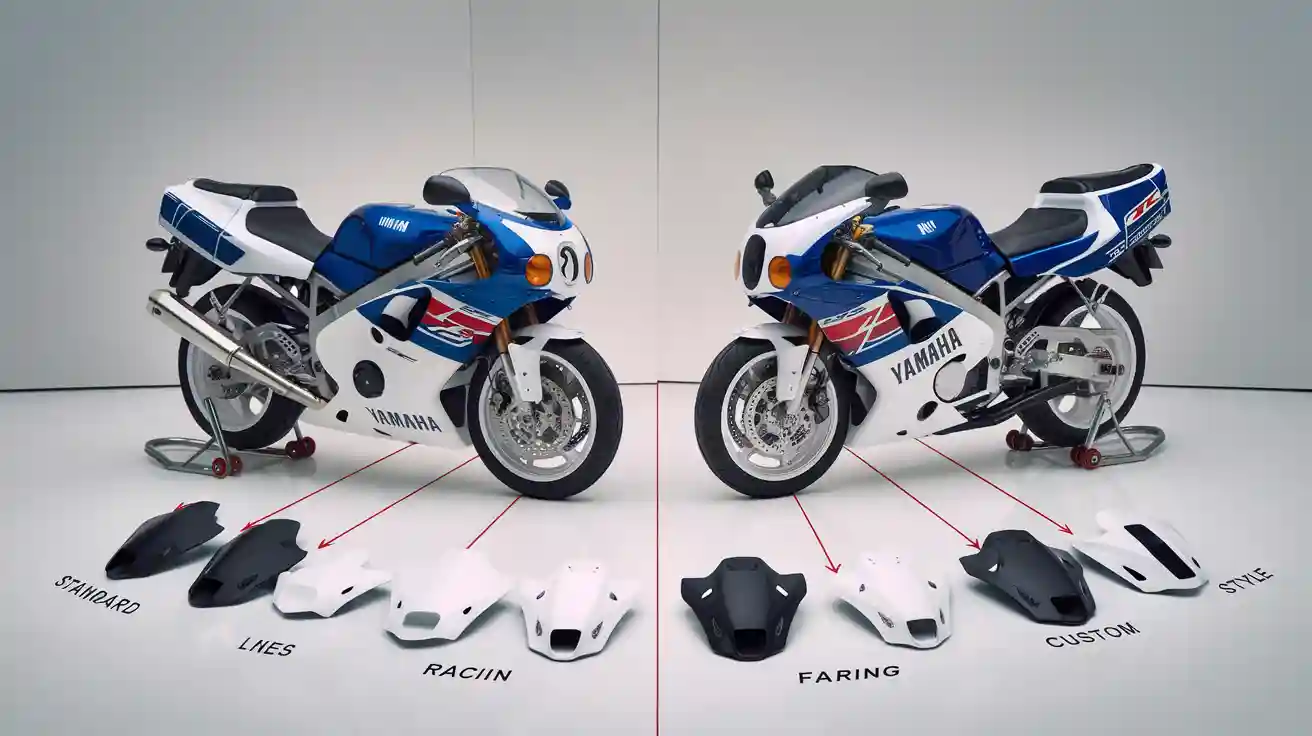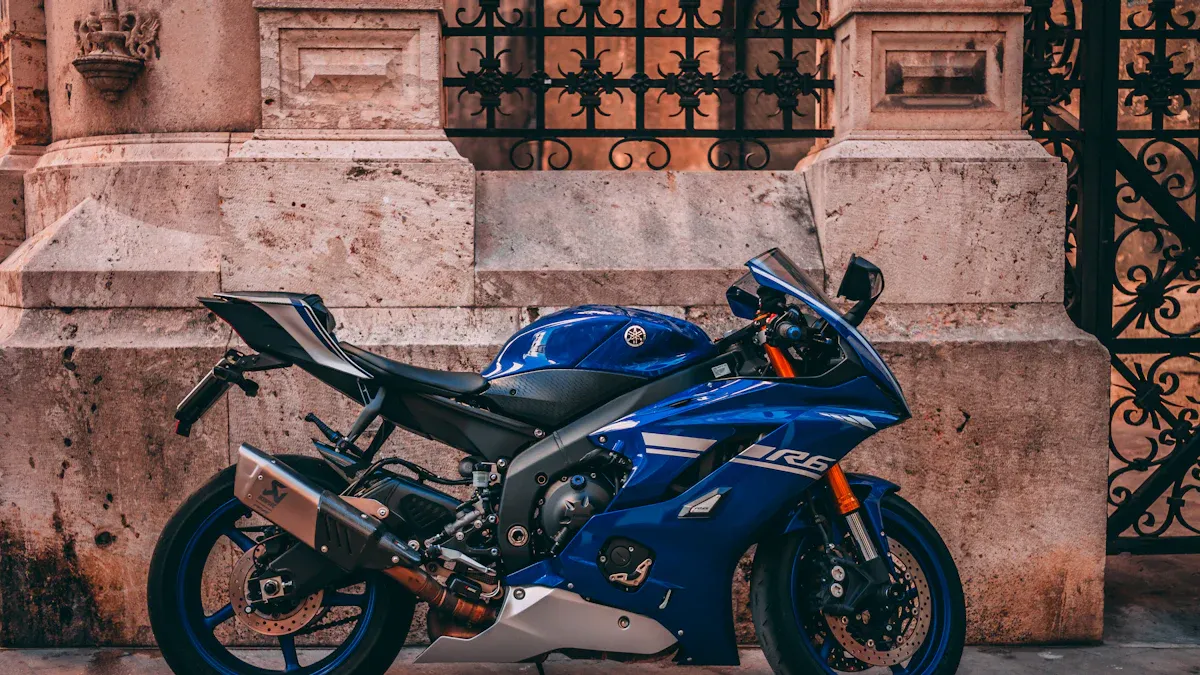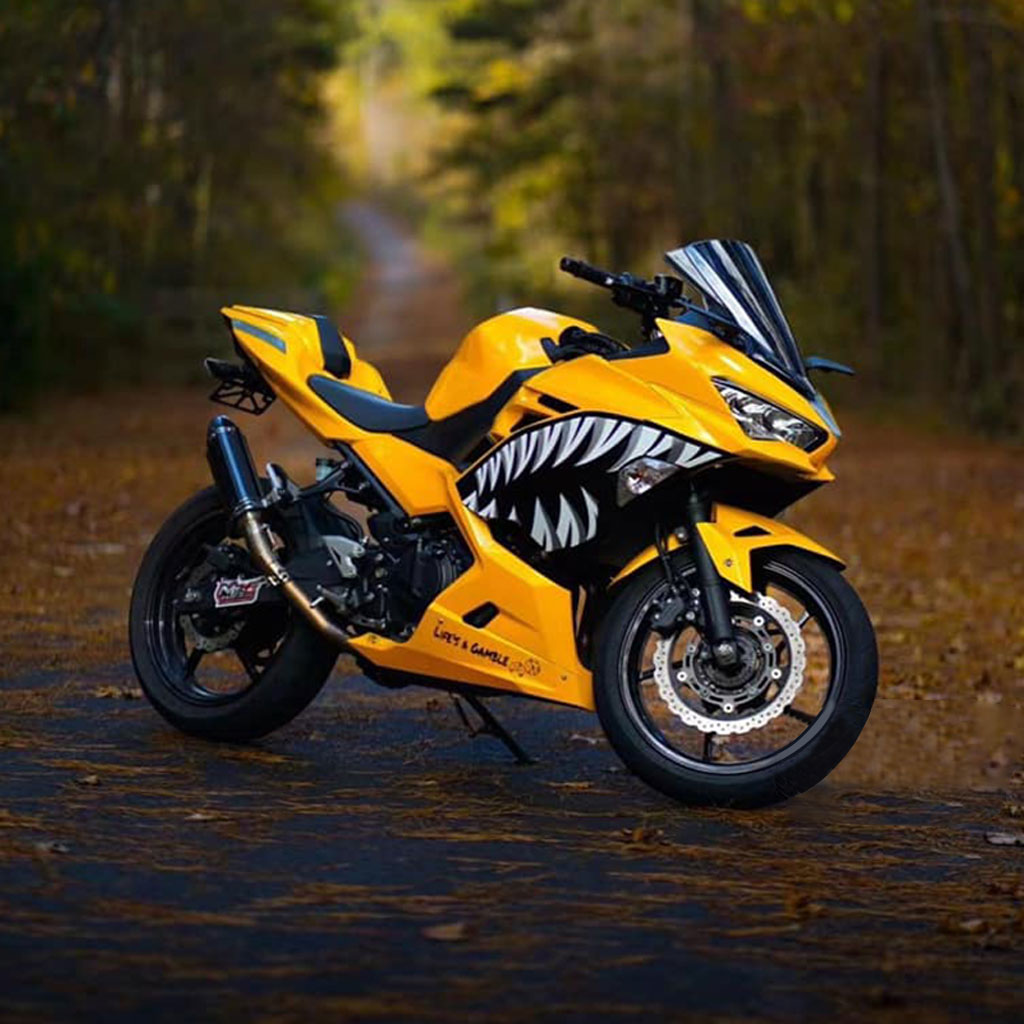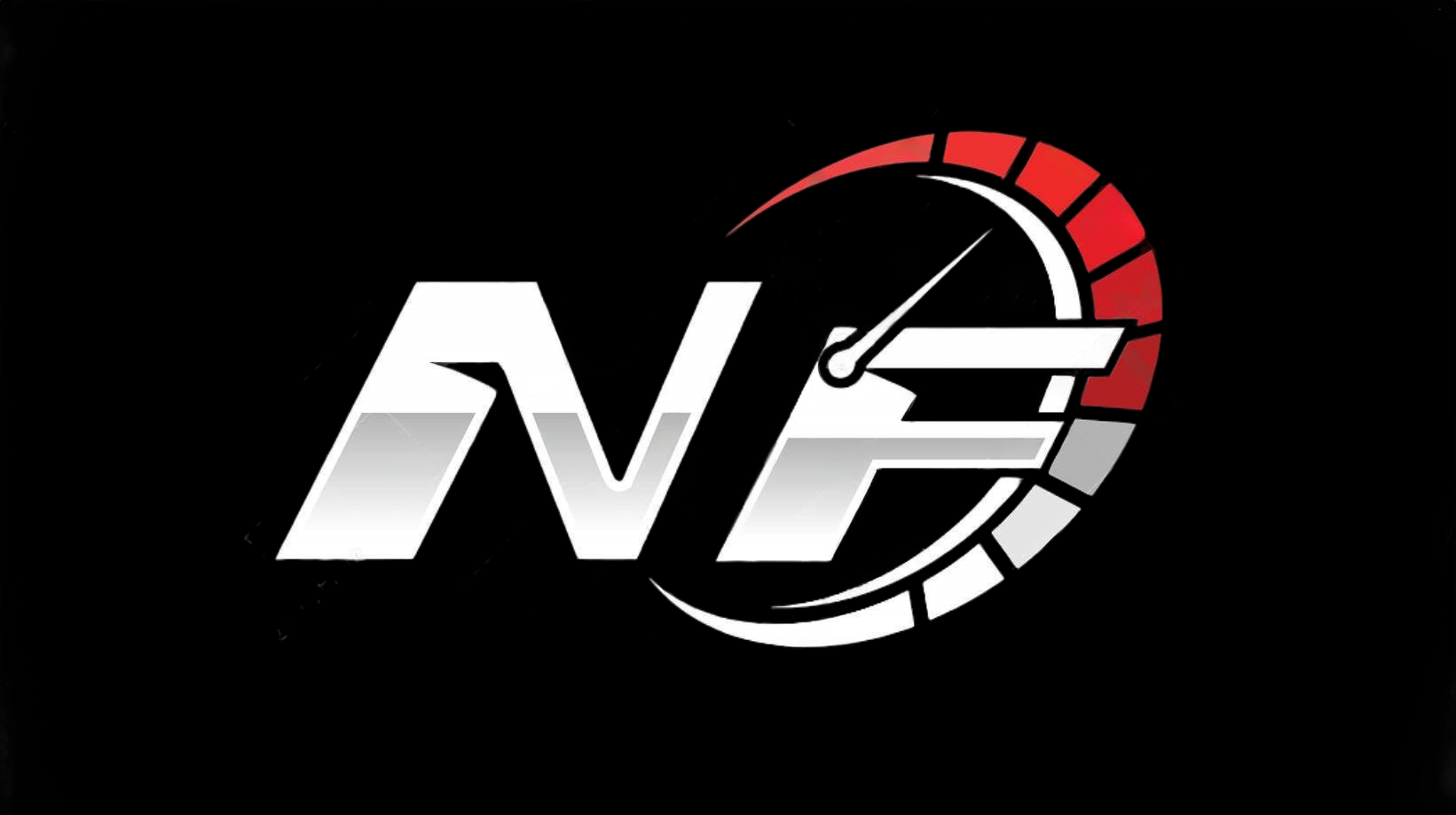Comparing the 2004 Yamaha R6 to the 2003 Model and Exploring Fairing Options

You might notice that the 2004 Yamaha R6 brings several updates over the 2003 model. The r6 2004 yamaha features changes in its engine, chassis, and styling. When you look at fairings, you will see that not all parts fit both years perfectly. This matters because choosing the right fairing helps you keep your bike looking sharp and performing well.
r6 2004 yamaha vs. 2003: Mechanical and Design Differences
Engine and Performance Updates
You will notice that the engine in the 2003 Yamaha R6 introduced fuel injection, which made throttle response smoother and increased peak horsepower by about three. Yamaha kept the same engine size and layout for the 2004 model. The main change came from remapping the fuel injection. This update improved how the throttle feels and made power delivery at high RPMs more consistent. Yamaha also added a larger exhaust canister to help the engine breathe better when you push it hard.
Here is a table that compares the main engine specifications and performance metrics:
| Specification | 2003 Yamaha YZF-R6 | 2004 Yamaha YZF-R6 |
|---|---|---|
| Engine Displacement | 599cc liquid-cooled inline four-cylinder | Same as 2003 |
| Horsepower | ~120-123 hp @ 13,000-14,500 RPM | Same peak hp, with remapped fuel injection for improved throttle response |
| Torque | ~50-57.5 lb-ft @ 12,000 RPM | Same torque, improved power delivery at high RPM |
| Compression Ratio | 12.4:1 | Same |
| Bore x Stroke | 65.5 x 44.5 mm | Same |
| Redline | 15,500 RPM | Same |
| Fuel Injection | Introduced in 2003 | Remapped for better throttle response |
| Exhaust System | Standard 4-into-2-into-1 aluminum exhaust | Larger volume exhaust canister |
| Tires | Standard tires | New Dunlop radial tires for improved grip |
| Dry Weight | 388 lb | Slight increase to 392 lb |
| 0-60 mph | 2.8 seconds | Same |
| Quarter Mile | ~10.8 seconds @ 128 mph | Same |
| Top Speed | 157-160 mph | Same |
You get the same horsepower and torque figures for both years. The 2004 model feels a bit sharper when you twist the throttle, especially at higher RPMs. Yamaha also switched to new Dunlop radial tires for the 2004 R6, which give you better grip on the road or track.
Chassis and Suspension Comparison
When you look at the chassis, you see that Yamaha kept the basic frame design for both years. The 2003 and 2004 models use an aluminum Deltabox frame, which helps keep the bike light and strong. The suspension setup stays similar, with an adjustable front fork and rear shock. You can tune these parts for your riding style, whether you like smooth city rides or aggressive cornering.
Tip: If you want a bike that feels stable and handles well, both the 2003 and 2004 R6 models deliver. The 2004 model’s slightly heavier weight comes from the new exhaust and tires, but you will not notice much difference in everyday riding.
Design and Aesthetic Changes
Yamaha made small but noticeable changes to the look of the r6 2004 yamaha. The fairings have sharper lines and a more modern shape. The headlight design looks sleeker, and the tail section sits higher, giving the bike a more aggressive stance. You will see new graphics and color options for 2004, which help the bike stand out.
- The 2003 model has a rounder, softer look.
- The 2004 model features sharper edges and a sportier profile.
- Both models keep the signature twin headlights, but the 2004 version appears more streamlined.
If you care about style, you might prefer the 2004 R6 for its updated appearance. These changes do not affect how the bike rides, but they make a difference if you want your motorcycle to look fresh and modern.
Electronics and Features Overview
When you compare the electronics and features of the 2003 and 2004 Yamaha R6, you see some important updates. Yamaha focused on making the bike easier to use and more reliable for riders like you.
You get a digital-analog instrument cluster on both models. The tachometer uses an analog needle, which helps you read engine speed quickly. The speedometer and odometer use digital displays. This mix gives you clear information while you ride.
In 2004, Yamaha improved the wiring harness. This change makes the electrical system more stable. You will notice fewer electrical problems if you ride often or in different weather. The 2004 model also uses better connectors. These connectors resist water and dirt, so you get fewer issues with corrosion.
Note: If you ride in the rain or wash your bike often, the 2004 model’s improved connectors help keep your electronics safe.
Both models come with a basic immobilizer system. This feature helps protect your bike from theft. You use a coded key to start the engine. If someone tries to use the wrong key, the bike will not start.
Here is a table that shows the main electronic features for each year:
| Feature | 2003 Yamaha R6 | 2004 Yamaha R6 |
|---|---|---|
| Instrument Cluster | Analog/Digital Combo | Analog/Digital Combo |
| Immobilizer | Yes | Yes |
| Wiring Harness | Standard | Improved, more durable |
| Connectors | Standard | Water-resistant |
| Headlights | Twin Halogen | Twin Halogen |
| Turn Signals | Standard Bulb | Standard Bulb |
| Battery | 12V, Lead Acid | 12V, Lead Acid |
You do not get advanced electronics like traction control or ride modes on these models. Yamaha kept the controls simple. This design helps you focus on riding and learning the basics of sport bikes.
If you want to add upgrades, you can install aftermarket gear like gear indicators, LED lights, or phone chargers. The improved wiring on the 2004 model makes these upgrades easier and safer.
Tip: Always check your bike’s wiring diagram before adding new electronics. This step helps you avoid short circuits or blown fuses.
You will find that both the 2003 and 2004 R6 models give you the essential features you need for daily riding or track days. The 2004 model’s small updates make it a bit more reliable and easier to maintain.
r6 2004 yamaha Fairing Compatibility and Interchangeability
OEM Fairing Fitment Between 2003 and 2004
When you look at the fairings for the 2003 and 2004 Yamaha R6, you see that most parts fit both models very well. The mounting points for the fairings stay the same, so you can swap panels between these years without trouble. You do not need to worry about the fairings falling off or not lining up. The injection molding process for these fairings makes the mounting tabs strong and secure. You get a solid fit that feels just like the original.
If you want to replace your fairings with aftermarket options, you find that most brands design their kits to bolt on easily. You do not need to make big changes or use special tools. The fairings come with a warranty, so you know they will last and look good. You get a close fitment that matches the factory parts.
Tip: Always check the mounting tabs before you install new fairings. A good fit keeps your bike safe and looking sharp.
Front Fender and Minor Variations
You might notice small differences when you compare the front fender and other details between the 2003 and 2004 models. The front fender design changes a little, but the mounting points stay the same. You can swap the fender between these years, but the look may not match perfectly. The color shades and graphic placements also change from year to year. These differences do not affect how the fairings fit or work. They only change how your bike looks.
When you buy aftermarket fairings, you see that the decal positioning and color can be slightly different from the original. These changes are cosmetic, not structural. You still get a fairing that fits well and protects your bike. If you care about matching the exact look of your bike, you should pay attention to these small details.
Here is a quick list of minor variations you might see:
- Decal placement
- Color shade differences
- Graphic style changes
- Slight front fender shape updates
Note: These variations do not change how the fairings mount or protect your bike. You only need to think about them if you want a perfect match for your bike’s style.
Compatibility with Yamaha R6S and Other Model Years
You get even more options when you look at compatibility with other Yamaha models. The fairings for the 2003, 2004, and 2005 R6 fit the Yamaha R6S from 2006 to 2009. You can use these fairings across different years and models. The mounting points stay the same, so you do not need to worry about making changes. The only differences you see are in the color scheme and the front fender design.
If you want to upgrade or replace your fairings, you can choose from a wide range of years. You get about 95% equivalence to the original parts. This means you get a fairing that fits well and looks good, with only small changes in style. The mounting tabs are built into the fairings during manufacturing, so you get a strong and reliable fit.
Callout: You can use fairings from the r6 2004 yamaha on the R6S and other compatible years. This gives you more choices and helps you save money when you need new parts.
Here is a table that shows fairing compatibility across different years:
| Model Year | Fairing Compatibility | Notes |
|---|---|---|
| 2003 Yamaha R6 | 2003, 2004, 2005, R6S | Minor color/fender changes |
| 2004 Yamaha R6 | 2003, 2004, 2005, R6S | Minor color/fender changes |
| 2005 Yamaha R6 | 2003, 2004, 2005, R6S | Minor color/fender changes |
| 2006-2009 Yamaha R6S | 2003, 2004, 2005 | Minor color/fender changes |
You get a lot of flexibility when you choose fairings for your Yamaha R6. You can mix and match parts from different years and models, as long as you pay attention to small style changes.
Aftermarket Fairing Options for r6 2004 yamaha

Recommended Aftermarket Brands
When you look for aftermarket fairings for your r6 2004 yamaha, you find several brands that stand out for quality and fit. Many riders and experts recommend these brands:
- HMCLUB: This brand designs fairing kits specifically for 2003-2005 Yamaha YZF-R6 models. You get a precise fit, strong mounting tabs, and a multi-layer paint finish that resists fading. Many users praise the color match and easy installation. The kit includes detailed instructions and hardware, making it a top choice for DIY projects.
- Fairing Express: You receive OEM-grade ABS plastic fairings with injection molding technology. The company guarantees a 100% OEM fit and uses the same methods as original Yamaha parts. You can order custom fairings, and each kit comes with all the mounting components you need.
- Monster Fairings: This brand offers high-quality ABS fairing kits with OEM-equivalent fitment. You get extras like a seat cowl, heat shielding, and a windshield. The price after discount is around $775, making it a popular option for riders who want value and quality.
- alFairings: You can buy a kit for about $600. These fairings use high-grade virgin ABS and offer about 95% fitment equivalence to OEM parts. The injection-molded tabs make installation easier and more secure.
Tip: Always check that the fairing kit you choose lists your exact model year for the best fit.
Material Choices and Durability
Most aftermarket fairings for the 2004 Yamaha R6 use high-grade ABS plastic. This material gives you flexibility and long-term resistance to impacts. Manufacturers use injection molding to create fairings that fit almost as well as the originals. You get mounting tabs built into the fairings, which makes them solid and easy to install.
| Material Type | Performance Features |
|---|---|
| ABS Plastic | Flexes under stress, resists cracking, and handles temperatures from -30°C to +120°C. UV-stabilized for 5+ years. Meets ECE 22.05 certification. Comes with a 12-month warranty and crash replacement discounts. |
| Fiberglass | Good for track use and budget-friendly. Uses UV-resistant gel coats. Offers reasonable durability but less repeat buyer confidence. Usually comes with a 12-month warranty. |
ABS plastic fairings balance cost, durability, and fit. You get a finish with three layers of UV paint and clear coat, which keeps your bike looking sharp for years.
Customization and Color Matching
You have many options to customize your fairings. Brands like Monster Fairings let you use a "Customize Now" feature to create your own design. OyOCycle offers fairings for the 2004 Yamaha R6 in both OEM styles and custom designs. You can pick from factory colors, flame patterns, or even branded decals. If you do not see the design you want, you can contact the company for special requests.
Manufacturers use a seven-stage paint process with UV-resistant coatings to match OEM colors closely. They apply multiple layers of paint and clear coat to ensure the finish lasts and matches your bike. Some companies offer free custom painting services, so you can specify the exact color and style before production.
Note: Custom fairings often include extras like heat shielding and windscreens, giving you more value for your money.
Selecting and Installing Compatible Fairings for r6 2004 yamaha
Fitment Tips and Best Practices
When you select fairings for your r6 2004 yamaha, you want to make sure they fit well and last long. Here are some important things to keep in mind:
- Always check that the fairings match your exact model year. This helps you avoid extra work or modifications.
- Choose the right material for your needs. ABS plastic is strong and light. Fiberglass works well for budget builds. Carbon fiber is the lightest but costs more.
- Think about your riding style. If you ride in the city, simple fairings may be enough. For racing or long trips, look for aerodynamic and sturdy options.
- Make sure you have all the correct mounting hardware. Stainless steel bolt kits designed for your bike help prevent rust and keep the fairings secure.
- Pay attention to the look and color. Custom fairings let you show off your style.
Tip: Careful preparation and using the right hardware make installation easier and help your fairings last longer.
Tools and Preparation
Before you start, gather the right tools and prepare your workspace. You will need:
- Torque wrench
- 4mm and 5mm hex keys (two 5mm)
- 8mm hex driver
- 12mm and 22mm sockets
- 3/8 or 1/2 inch ratchet
- Blue and red thread locker
Follow these steps to get ready:
- Clean your bike and old fairings with a degreaser.
- Unpack new fairings and place them on a soft blanket.
- Remove bolts from the fuel tank and clean the area.
- Use OEM rubber grommets and foam to protect parts.
- Check mounting holes and redrill if needed.
- Remove and transfer parts like headlights and mirrors.
- Test fit each fairing piece before final installation.
Note: Take your time and keep all small parts organized to avoid losing anything.
Common Installation Challenges
Installing fairings can be tricky. You may face these common problems:
- Keeping track of many bolts, clips, and washers.
- Handling different fasteners, such as hex bolts and plastic rivets.
- Disconnecting electrical parts like headlights and turn signals.
- Working in tight spaces with small fasteners.
- Removing and reinstalling parts like windscreens and mirrors.
Stay patient and work step by step. Use masking tape to hold fairings in place if needed. Always double-check that all bolts and clips are secure before riding.
You see that the 2003 and 2004 Yamaha R6 models share almost everything, with only minor changes in color and graphics. Riders call these bikes comfortable and strong, making them great for street use. When you choose fairings for your r6 2004 yamaha, you get many options that fit well across these years. Look for kits with solid paint, clear coats, and good color matching. You can protect your fairings by adding UV coatings or waxing often. Balancing price, quality, and finishing work helps you get the best results.
- The 2003 and 2004 R6 are nearly identical, often grouped as the R6S.
- Aftermarket fairings vary in quality; professional painting and UV protection improve durability.
- OEM replica stickers are rare, so plan for custom touches.
Tip: Always check fitment and finish before installing new fairings.
FAQ
Can you use 2003 Yamaha R6 fairings on a 2004 model?
Yes, you can use 2003 fairings on a 2004 R6. The mounting points match. You may notice small differences in color or graphics, but the fit stays secure.
What tools do you need to install new fairings?
You need a torque wrench, hex keys, sockets, and a ratchet. Keep a clean workspace and organize your bolts. Using the right tools helps you avoid damage.
Are aftermarket fairings as strong as OEM parts?
Most aftermarket fairings use ABS plastic. This material resists cracks and holds up well. Some brands offer extra UV protection. Always check reviews before you buy.
How do you keep fairings looking new?
Wash your fairings with mild soap and water. Dry them with a soft cloth. Wax the surface every few months. Store your bike indoors to protect the paint from sun damage.
See Also
Top Yamaha R6 Fairing Kits Reviewed For Style And Performance
Reasons Yamaha R6 Fairings Should Be Your Essential Gear
Best Aftermarket ZX6R Fairings Evaluated For Quality And Fit
Comparing OEM And Aftermarket Fairings For Ninja 500 Motorcycles
Advantages And Disadvantages Of Custom Ducati Panigale V4 Fairings

